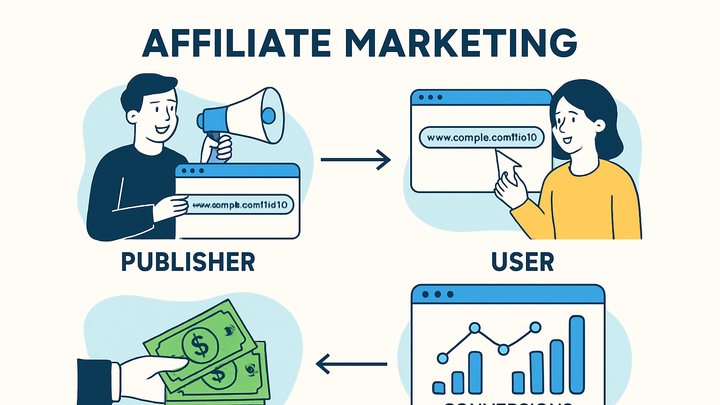Published on 2025-06-27T18:59:52Z
What is Affiliate Marketing? Examples and Tracking
Affiliate marketing is a performance-based marketing channel where partners (affiliates) promote a merchant’s products or services and earn a commission for each sale, lead, or action driven through their unique referral links. In analytics, affiliate marketing tracking is crucial to accurately attribute conversions and measure ROI. By combining UTM parameters, conversion pixels, and advanced attribution models, businesses can optimize their affiliate programs for better growth and transparency. With the rise of privacy regulations and browser restrictions on cookies, modern tools like PlainSignal (cookie-free analytics) and GA4 adapt to ensure reliable affiliate performance measurement. Whether you’re launching a new affiliate network or refining an existing one, understanding the end-to-end tracking setup and best practices will help you scale effectively.
Affiliate marketing
Performance-based marketing where affiliates earn commissions for driving conversions, tracked via UTM tags and analytics tools.
Understanding Affiliate Marketing
This section introduces the core concept of affiliate marketing and explains how it integrates with web analytics.
-
Definition
Affiliate marketing is a performance-driven channel where affiliates promote a merchant’s products and earn commissions for each referred conversion.
-
Key components
The affiliate ecosystem consists of specific roles and elements that work together to drive and track performance.
-
Affiliates
Individuals or entities that promote a merchant’s offerings via unique referral links.
-
Merchants
Brands or businesses that offer products or services through an affiliate program.
-
Networks
Platforms that connect affiliates with merchants and manage tracking, reporting, and payments.
-
Consumers
End-users who click affiliate links and complete desired actions (purchases, sign-ups).
-
-
How it works
Affiliates embed tracking links in their content. When a user clicks the link and completes a conversion event, the affiliate earns a predefined commission.
Tracking Affiliate Performance
Analytics is essential to attribute conversions, calculate ROI, and optimize affiliate campaigns for maximum effectiveness.
-
Utm parameters
Tag affiliate URLs with UTM parameters to capture source, medium, campaign, and other metadata in analytics reports.
-
Utm_source
Identifies the referring affiliate or network.
-
Utm_medium
Specifies the marketing channel (e.g., affiliate).
-
Utm_campaign
Names the specific affiliate campaign or promotion.
-
Utm_content
Differentiates ads or links within the same campaign.
-
Utm_term
Tracks paid keywords, if applicable.
-
-
Conversion tracking implementation
Implement analytics scripts or pixels to record when an affiliate-driven user completes a desired action.
-
PlainSignal code snippet
Use PlainSignal’s cookie-free script to capture affiliate conversions and pageviews.
-
GA4 event tag
Configure a
purchaseorsign_upevent in GA4 via gtag.js or GTM, including affiliate metadata.
-
-
Attribution models
Choose an attribution model that defines how credit is assigned to affiliates across touchpoints.
-
Last-click
Gives full credit to the final touch before conversion.
-
First-click
Awards the initial affiliate interaction.
-
Linear
Distributes credit equally across all touches.
-
Time-decay
Allocates more credit to recent interactions.
-
Implementing with SaaS Analytics Tools
Step-by-step integration of affiliate tracking using leading analytics platforms like PlainSignal and GA4.
-
PlainSignal integration
Insert the following snippet in your website’s
<head>to enable cookie-free affiliate tracking:<link rel="preconnect" href="//eu.plainsignal.com/" crossorigin /> <script defer data-do="yourwebsitedomain.com" data-id="0GQV1xmtzQQ" data-api="//eu.plainsignal.com" src="//cdn.plainsignal.com/plainsignal-min.js"></script> -
GA4 integration
Configure affiliate event tracking with Google Analytics 4 via gtag.js or Google Tag Manager.
-
Gtag.js setup
Include the GA4 gtag.js script and send an event with affiliate parameters:
gtag('event', 'purchase', { 'transaction_id': 'T12345', 'value': 99.99, 'currency': 'USD', 'affiliate_source': 'PartnerA' }); -
Gtm setup
Use Google Tag Manager to create a trigger for conversions and map affiliate UTM parameters to event fields.
-
Best Practices & Tips
Optimize your affiliate program with clear structures, compliance measures, and continuous monitoring.
-
Choose the right partners
Select affiliates whose audience aligns with your brand values and target demographics.
-
Set clear commission structures
Define transparent, competitive commission rates and payment terms to motivate affiliates.
-
Ensure compliance
Disclose affiliate relationships and adhere to privacy regulations like GDPR and CCPA.
Challenges and Solutions
Common hurdles in affiliate analytics and strategies to overcome them.
-
Cookie restrictions
Browser and device settings can block third-party cookies, leading to lost tracking data.
-
Solution
Adopt cookieless analytics like PlainSignal or implement server-side tracking.
-
-
Attribution gaps
Cross-device user journeys and offline conversions can create incomplete attribution.
-
Solution
Use multi-touch attribution models and data stitching across channels.
-
-
Data privacy impact
Privacy laws and consent requirements may limit data collection capabilities.
-
Solution
Implement user consent banners and privacy-first analytics configurations.
-
